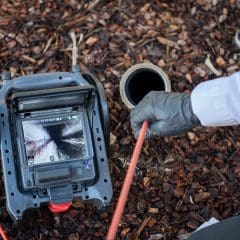CCTV drain surveys are essential for understanding how rats are entering your property, so carrying out investigations on rat prevention and preventing them from getting back in. Rats are attracted to sewer environments due to the ready access to food, shelter, water, and convenient travel corridors. They exploit drains for nesting, escaping threats, and accessing food sources present in the sewer system. The interconnected network of tunnels provides them with easy movement and can lead to rats breaching onto residential properties.
Identifying entry points, assessing the extent of infestation, and locating nesting sites are key reasons for conducting CCTV surveys. These inspections help in understanding rat behavior, implementing targeted interventions, and preventing re-infestation. Rats often use sewer systems to access homes, taking advantage of damaged pipes or neglected maintenance. By sealing entry points, addressing structural issues, and implementing sanitation measures, these surveys contribute to efficient pest control, compliance with regulations, and the prevention of long-term rat-related problems.
Rats are attracted to drains and sewers for several reasons, and their presence in these systems can lead to issues breaching into homes:
Access to Food Sources
Drains and sewers often contain organic matter and food debris, providing a readily available food source for rats. The presence of food waste can attract rats to these areas, leading to infestations.
Shelter and Nesting Opportunities
Sewers provide rats with a dark and sheltered environment, making them suitable for nesting and breeding. Rats seek refuge in the warmth and seclusion of drains, creating nests and establishing colonies.
Water Source
Rats require water for survival, and drains often contain moisture. Sewers offer a consistent water source, attracting rats in search of hydration, especially in urban areas where alternative water sources may be limited.
Travel Corridors
Sewers and drainage systems create an extensive network of interconnected tunnels and pipes. Rats are skilled burrowers and can use these tunnels as travel corridors, allowing them to move around discreetly and access different areas.
Escape Routes
Rats are intelligent and cautious animals, and drains provide convenient escape routes when they feel threatened. The interconnected nature of sewer systems allows rats to quickly move away from predators or disturbances.
Warmth and Comfort
The temperature in sewer systems tends to be relatively stable compared to the external environment. During harsh weather conditions, rats seek the warmth and comfort offered by drains and sewers.
Breaching onto Homes
Rats can breach homes via sewers due to various reasons. Entry points, such as cracks, displacements in pipes or openings in sewer pipes, allow rats to navigate from the sewer system into residential properties. Once inside, they can cause damage, contaminate food, and pose health risks.
Search for Additional Resources
If the food supply within the sewer system becomes scarce, rats may venture out in search of alternative food sources. This can lead them to homes and businesses, where they may find accessible food waste or improperly stored food.
Population Density
In urban environments, the concentration of human activity can contribute to an abundance of food waste in sewers. High population density provides rats with ample opportunities for scavenging and establishing colonies, increasing the likelihood of breaching residential properties.
Neglected Maintenance
Poorly maintained sewer systems with damaged pipes, unrepaired cracks, or inadequate sealing create favourable conditions for rats to enter and exit. Neglected maintenance increases the risk of rat-related issues affecting nearby homes.
Addressing rat issues at the source in drains and sewers is essential for integrated pest management and effective pest control. Proper maintenance, sealing entry points, and implementing sanitation measures in and around drain systems can help prevent rats from breaching homes and causing problems for residents.











